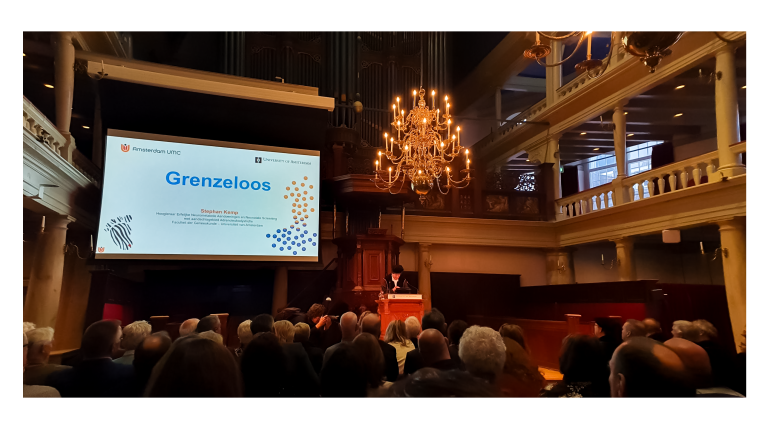On January 29, 2025, Professor Stephan Kemp gave his inaugural lecture in the beautiful “Oude Lutherse Kerk” of the University of Amsterdam. On July 1, 2024, Kemp was appointed full professor of Inherited Neurometabolic Disorders and Newborn Screening at the Faculty of Medicine of the University of Amsterdam.

Newborn screening and the "grey zone"
Newborn screening is one of the most successful public health programs in the Western world. Newborn screening identifies individuals with conditions for which early diagnosis and effective treatment can have a significant impact on infant morbidity and mortality.
With medical tests such as genetic screening or blood work, we often expect a clear yes or no answer. But the reality is more complex. Genetic screening can also identify mild variants, non-disease variants, and variants of uncertain significance (VUS). Biochemical tests can produce results that fall into a "grey zone”: higher than normal, but not high enough to be certain of the diagnosis. Identifying a VUS or grey zone value is challenging in terms of diagnostic uncertainty and confusion.
The fine balance between accuracy and reliability
In recent years, it has become clear that population screening, including newborn screening, is identifying genetic variants that were not previously identified, either because they were not associated with disease or because they are associated with mild symptoms at the extreme end of a clinical spectrum and went unnoticed.
Newborn screening uses dried blood spots to determine the levels of selected metabolites that may indicate the presence of a particular disorder. These tests typically have a predetermined cut-off level that is used to determine whether a result is considered screen positive or negative for a particular disorder. The cut-off for a newborn screening test determines the sensitivity and specificity of the test. Overall, for disorders in which an elevated metabolite is indicative of disease (such as elevated phenylalanine for babies with phenylketonuria), a lower cut-off may increase the sensitivity of the test and decrease the likelihood of missing a true positive result. However, it will also increase the number of false positives, including VUS and non-disease-causing variants. On the other hand, a higher cut-off may decrease the number of false-positive results but may also increase the likelihood of missing true positive results. Thus, there is a fine balance between the accuracy and reliability of the screening process.
While the goal of “not missing a patient” is understandable, the consequences of false positive results should not be underestimated. False positive results can lead to several negative outcomes, such as significant stress and anxiety for parents who may have to wait for additional testing to confirm the diagnosis, increased health care costs, financial burden for families who may have to pay for additional testing, medical harm, and high false-positive rates can reduce public confidence in newborn screening programs; potentially leading to decreased participation and reduced effectiveness of the program.
Unbinding the boundaries of sick and healthy
Indeed, Stephan Kemp's research on newborn screening for adrenoleukodystrophy (ALD) illustrates the complexity of medical diagnosis and reminds us that the boundaries between 'sick' and 'healthy' are often more boundless (Grenzeloos) than we might think.
As newborn screening programs expand to include more treatable conditions, a shift to genetic screening becomes increasingly feasible as technology costs decrease. However, careful implementation is essential. The American experience demonstrates the risks of disrupting diagnostic pathways by outsourcing screening to commercial entities, potentially compromising the involvement of academic centers and metabolic experts.
A two-step approach - combining genetic testing with diagnostic biomarker determination – can distinguish between harmless and disease-causing DNA variants, avoiding unnecessary patient labeling while maintaining diagnostic accuracy.
This challenge underscores the importance of collaborative and innovative research. In this boundless quest for knowledge and improved care, we are reaching across national borders, sharing diagnostics and knowledge to improve patient care and minimize the impact of inconclusive results.

Stephan Kemp giving his inaugural lecture titled "Boundless (Grenzeloos)".
In his inaugural lecture, he spoke about his passion, accumulated knowledge and research on the metabolic disease ALD, the successful nomination of ALD for inclusion in the Dutch newborn screening program, the challenge of developing an algorithm to screen only boys for ALD, the experience of families, the start of ALD newborn screening in the Netherlands on October 1, 2023, and the worldwide “Grey Zone Project” he developed and leads when diagnostic results do not provide a clear yes or no answer.
The inaugural lecture can be viewed at:
🔗 https://lnkd.in/e8F7B6X8

